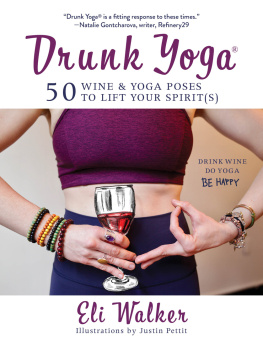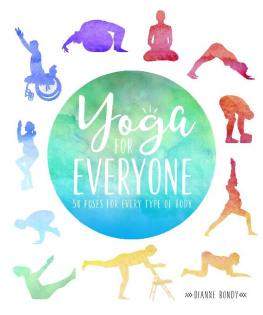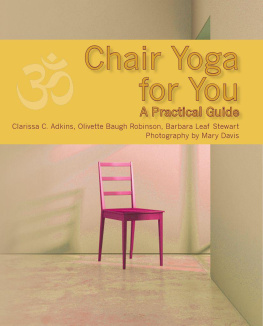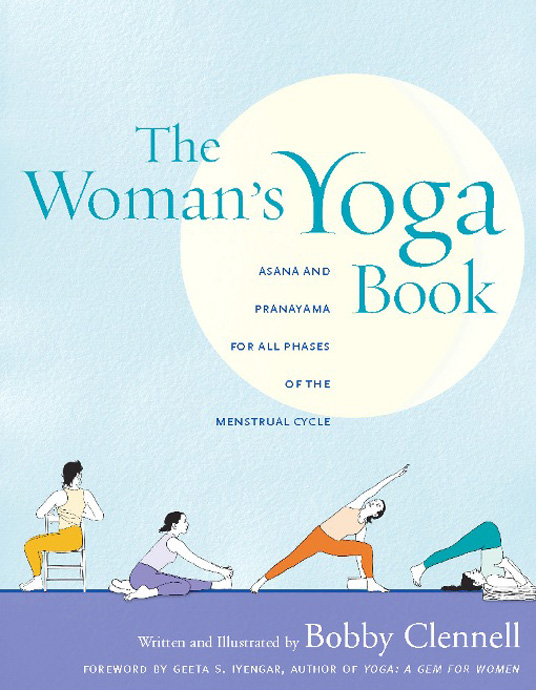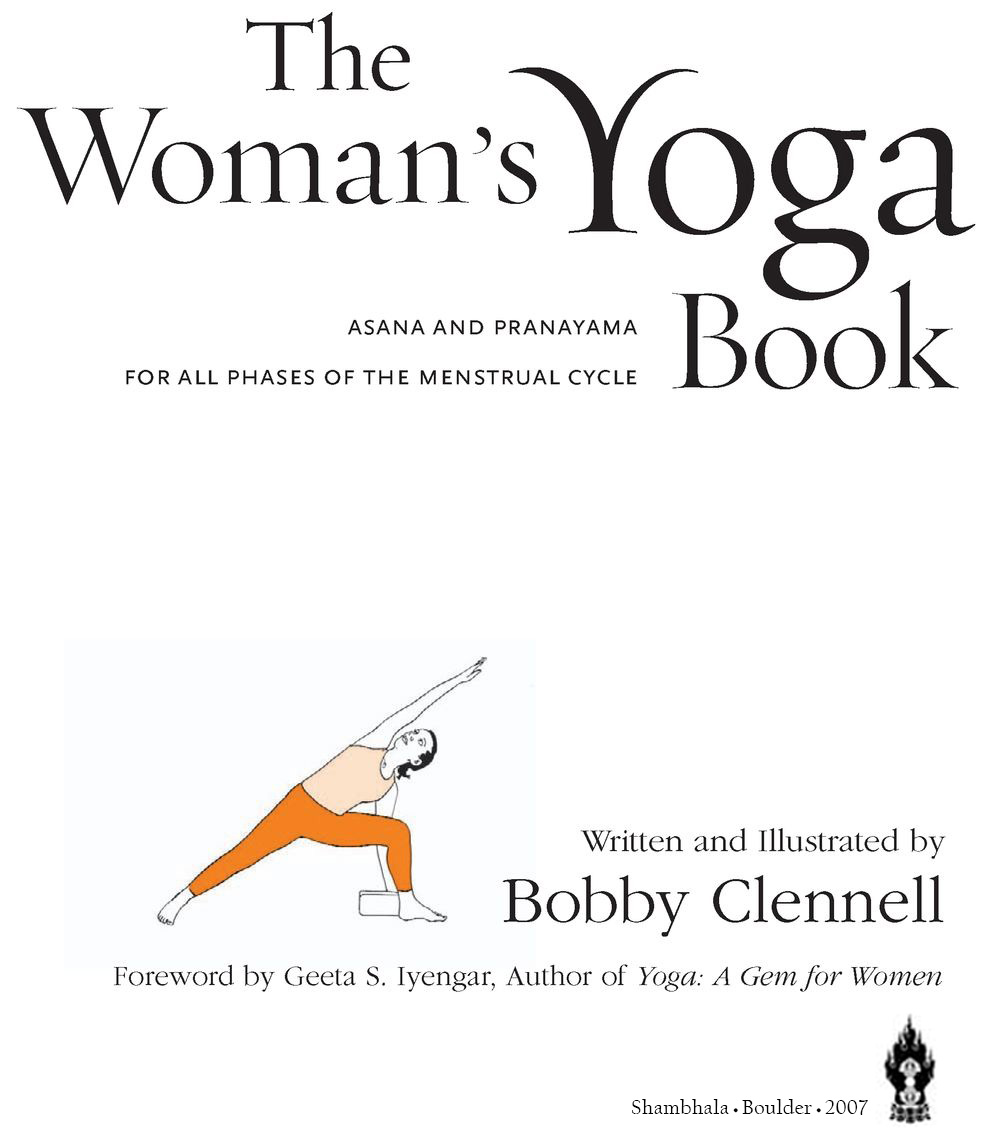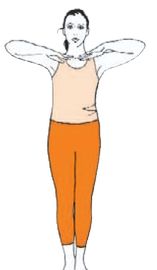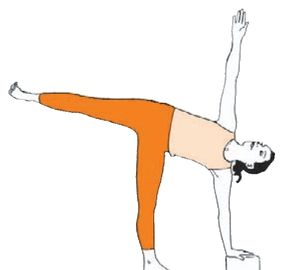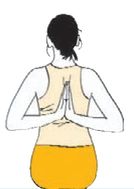Table of Contents
For my mother, Philippa Judd
Acknowledgments
THIS BOOK is based on the work of my beloved yoga teacher, B. K. S. Iyengar, who is the source of my yoga knowledge. A heartfelt thank you to Mr. Iyengars daughter, Geeta Iyengar, for her awe-inspiring teaching and especially for her dedicated and innovative work in the field of womens yoga.
This book could not have been written were it not for the hard work of some talented people. I would like to thank my publishers, Linda Cogozzo and Donald Moyer. Linda helped me collect and organize my thoughts, and with patience and perseverance made the writing and editing process seem painless and seamless. Thank you to Mary Talbot, who helped me find my voice in the early stages of writing, and to Lara Owen and Vivien Goldman who contributed to the preliminary editing process. I am deeply indebted to Iyengar Yoga teachers Joan White, Chris Saudek, and Lois Steinberg for their insights. Lois allowed me to spend inordinate amounts of time picking her brain. This book would not be as coherent as it is without her help.
Special thanks to my husband Lindsey, for his love and unconditional support. With his long experience as a yoga teacher and his unique abilities as a writer, he was always ready to offer a little literary fairy dust when I needed it. Lindsey and Hisayo Kushida took hundreds of photographs of me, on which I based the illustrations. A huge bouquet of red roses to each of you! Thank you also to my sons, Miles and Jake, for their love and encouragement.
For assistance with individual chapters, I acknowledge Frank Lipman, M.D., L.Ac.; Maryanne Travaglioni, L.Ac.; Harriet Beinfield, L.Ac.; and Efrem Korngold, L.Ac., O.M.D. I also thank Marcel Pick, R.N.C., M.S.N., N.P., and Leslie Boyde, M.D., for their help. Thank you to Roberta Atti for her wisdom and advice on the healing power of food.
I owe much to my friends and yoga students: Peter Simmons, Rob Gagnon, Joan Snyder, Maggie Cammer, and Diane von Furstenberg. Thank you to the many fine Iyengar Yoga teachers who helped in so many ways: Brooke Myers, Jean Marie Derrick, Yvonne Decock, Alison Pomroy, Sally Rutskey, Carrie Owerko, and Rajiv Mehta. Thank you to the late Penny Nield-Smith, Silvia Prescott, Mary Dunn, John Schumacher, Jawahar Bangera, Gabriella Giubilaro, and Stephanie Quirk.
And last but not least, a big thank you to my yoga students, who give me much more than they could ever know.
Foreword
BY GEETA S. IYENGAR
THE POPULARITY OF YOGA is increasing day by day, and it is delights my heart that many more people are embracing yoga today, as compared to the past. There was a time when many felt that yoga was meant only for recluses. However, today they understand the importance of yoga in daily life. There once was a mindset that yoga was meant exclusively for men. People realize now that this ancient art and philosophy was also a way of life for women of the Vedic period.
Yoga has a great potency to yield physical and mental health, which is essential for women. However, women should not forget its spiritual depth. The ancestral dynasty of women in yoga proves that besides physical health, they also strived for spiritual health to enrich their lives. Their endeavor did not make them turn their backs on their worldly and family responsibilities. This balance has to be struck by women of today, when the modern way of life makes them forget their womanhood.
The first stage of womanhood is menarche. In olden days, this event was celebrated as a girls second birth; there was a naming ceremony and her horoscope (birth chart) was drawn. Thus her life was molded such that she could improve her physical, moral, mental, and spiritual health.
I grew up witnessing the importance of yoga in my life. I could sense that the practice of yoga was developing a new personality in me by bringing inner balance. As I began teaching yoga, these imprints surfaced, so I could help and educate others.
Teaching yoga in the1960s was an adventure. Though the women were keen to learn, they had health problems. They wanted natural remedies instead of painkillers. At the time, it was not widely known that many of their problems, whether physical, psychological, or emotional, are related to menstruation and hormonal changes. I understood that link, and my method of teaching helped the women, though it took the female students a long time to adopt this view. Research today proves this link. Hence, a woman should respect her femininity and practice yoga accordingly.
Bobby Clennell rightly focuses on the practice of yoga during the different phases of menstruation, so this book is very useful for a woman from her menarche to menopause. Women will find answers to many problems they might face during that time of life. Each chapter explains the benefits of practicing the asana, while also cautioning the practitioner about what not to do and when not to do.
The journey of yoga starts with standing asanas, stabilizes one in sitting asanas, creates mobility in lateral extensions, settles one in forward extensions, brings restoration in supine asanas, refreshes one by bringing inner balance in inversions, rejuvenates the brain and nerves in backward extensions, and energizes one through pranayama. Bobby takes the reader through this entire journey. Her clear illustrations further enhance the value of the book.
I hope it will guide one and all.
Introduction
OF ALL THE CHANGES that have taken place throughout the last century, perhaps the most radical have been those in the lives of women. For the first time in history, many women in the West expect to take their place alongside men in the professional arena. But as womens opportunities and successes have expanded, their happiness and well-being have not always kept pace. In fact, women may be paying a price for having it all.
Many women find that the accelerated pace of life threatens to undermine their health, erode their sense of self, and shake their spiritual center. The pressure of living up to expectations adds to the stress of a hectic schedule. This stress, along with other aspects of modern life, such as environmental pollutants and junk food, can contribute to the breakdown of the immune system and disturbances of the hormone system, putting women at risk for problems such as fibroid tumors, endometriosis, ovarian cysts, and menstrual irregularities.
Without a doubt, the pattern of menstruation has been altered by postindustrial life. Because todays woman starts her period earlier and has fewer babies, she can have between 350 and 400 menstrual periods throughout her lifetime, as opposed to the 100 periods that most women experienced two hundred years ago. At one time, pregnancy and lactation provided respite from the monthly period, but women now have far fewer children than their foremothers, and many do not have children at all. This change, plus the demands that women face in the modern world, may be forcing the female reproductive system to adapt in unhealthy ways. Whether we have children or not, women are focused on keeping up. Listening to internal needs falls low on the list of priorities, and inevitably many women adopt unhealthy lifestyles, hardly noticing what is happening in our bodies.


